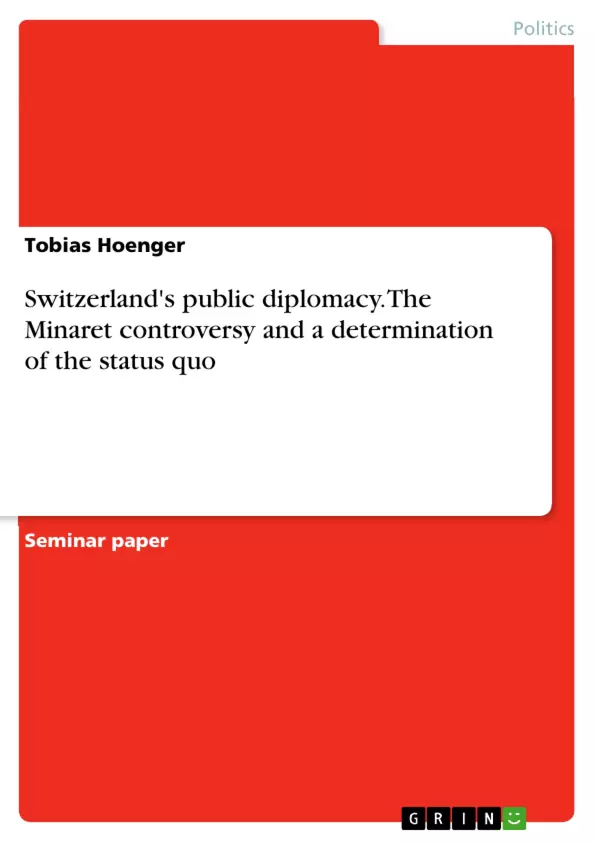It is the aim of this paper to explore Switzerland’s public diplomacy efforts in the light of the “Minaret debate” (from 2007-2009). This case study could be seen as an example of Switzerland’s public diplomacy effort to protect (maintain) the image of the country abroad. On the basis of the Minaret initiative, it is possible to extract and analyse the different parts of a public diplomacy theory by asking, inter alia, the following questions: Who was the actor? What was the foreign policy aim? Who was the target audience and what was the message used? What tools and channels did the actor use?
The case analysis will further help to determine the status quo of Switzerland’s communication abroad (and in this sense the public diplomacy).
The “status quo” is thereby the situation in which the actor, “Presence Switzerland”, operates nowadays (2013). In order to speak about the “status quo”, and to draw some conclusions at the end, it is helpful to define the “status quo ante”. In this sense, the author defines the “status quo ante” as the time before 2007 and the “status quo” as the time after 2007 until the present day. The reason for this clear cut is a change in the public diplomacy model; “Presence Switzerland” (the official public diplomacy agency in Switzerland) went through a changing process in the years from 2007 to 2009. The former PRS (Presence Switzerland) was an agency assigned from the government, with the task to conduct image branding abroad. It compromised members from the federal administration, members from partly state-run organizations and as well members from private organizations. Oppose to that, the later Presence Switzerland (from 2009) was a sub-agency of the Federal Department of Foreign Affairs, which means a complete government institution.
Not least because of this differentiation, this paper will eventually provide an example of how a state actor conducts public diplomacy and therefore has the chance to contribute to the relatively young academic field of public diplomacy.
Table of Contents
- Introduction
- The Minaret debate
- Background
- Swiss public diplomacy effort
- The actor
- Foreign Policy Aim
- Target audience and the used message
- Tools and channels
- Public Diplomacy Success?
- Presence Switzerland today
- Defining a status quo?
- Conclusion
Objectives and Key Themes
This paper aims to explore Switzerland's public diplomacy efforts in the context of the "Minaret debate" (2007-2009). It analyzes the debate as a case study of Switzerland's efforts to maintain the country's image abroad. The paper examines key components of public diplomacy theory, including the actors involved, foreign policy objectives, target audiences, messages used, and communication tools. It further investigates the impact of the Minaret initiative on Switzerland's public diplomacy efforts, particularly the "status quo" of Switzerland's communication abroad.
- Switzerland's public diplomacy strategy
- The impact of the Minaret debate on Switzerland's image abroad
- The role of "Presence Switzerland" in shaping public diplomacy
- The evolution of Switzerland's public diplomacy model
- The influence of direct democracy on public diplomacy
Chapter Summaries
The introduction sets the context for the paper, outlining its aim to explore Switzerland's public diplomacy efforts in light of the "Minaret debate." It establishes the "status quo ante" and "status quo" as relevant reference points for analysis.
Chapter 1 delves into the "Minaret debate," providing a detailed background on the origins and development of the initiative. It examines the role of the Swiss Peoples Party (SVP) and the international media coverage surrounding the debate. The chapter analyzes the potential threat to Switzerland's image abroad posed by the negative media coverage and the SVP's political agenda.
Chapter 2 discusses "Presence Switzerland," the official public diplomacy agency in Switzerland. It examines the agency's evolution from 2007 to 2009, highlighting its transition from a government-assigned agency to a sub-agency of the Federal Department of Foreign Affairs. The chapter explores the significance of this change for Switzerland's public diplomacy efforts.
Keywords
The key terms and concepts explored in this paper include public diplomacy, image branding, direct democracy, Swiss Peoples Party (SVP), Minaret debate, "status quo ante," "status quo," Presence Switzerland, foreign policy, target audience, communication channels, and media coverage.
- Citar trabajo
- MA Tobias Hoenger (Autor), 2013, Switzerland's public diplomacy. The Minaret controversy and a determination of the status quo, Múnich, GRIN Verlag, https://www.grin.com/document/316803



